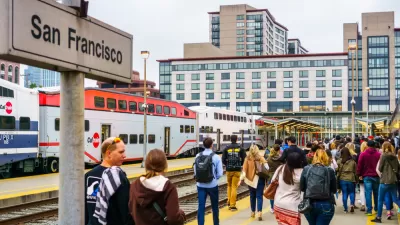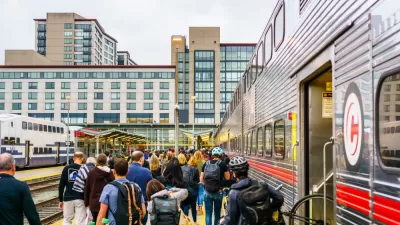Despite a flurry of new commuter rail lines in operation, ridership increased a mere .5% during a record year for transit. Worse yet, some of the newer lines saw the greatest decreases. The answer: increase service to attract riders.

Tod Newcombe, Senior Editor of Governing's Urban Notebook, looks at the problem, and offers one potential solution.
Last year, when the "U.S. Experienced It's Second-Highest Transit Ridership Since 1957", commuter rail ridership increased .5% while total transit ridership jumped 1.5%. In addition, "10 out of 28 systems lost riders; decreases occurred at some of the newest commuter lines..."
As the American Public Transportation Association (APTA) report issued last March posted here notes, commuter rail was public transit's worst performer, behind light rail, heavy rail, and large bus systems.
The biggest problem commuter rail faces is that its customer base lives in far-flung suburbs where cars are used for just about everything. “You are trying to attract people who are the least likely to use transit in the first place,” says Yonah Freemark, editor of The Transport Politic.
According to Wikipedia, "Northstar runs 40 miles (64 km) from Big Lake to downtown Minneapolis at Target Field using existing track and right-of-way owned by the BNSF Railway. Extension plans are on indefinite hold due to insufficient ridership."
The other three lines noted by Newcombe saw significantly greater ridership losses. Rail Runner (Albuquerque, N.M.), Trinity Railway Express serving Dallas-Fort Worth, and Music City Star (Nashville, Tenn) saw ridership drops of 9%, 7.7%, and 6.4% respectively. For other commuter rail lines, some of which saw substantial ridership gains, see page 5 of the March, 2013 American Public Transportation Report (PDF).
Newcombe writes that the solution, though sounding "counterintuitive, involves more service", though he doesn't suggest building extensions. He points to the Metro-North Railroad, with ridership up 1.2% last year. "After watching ridership decline for decades on its line, the MTA added more off-peak and weekend service, as well as another 187 trains, representing the most ambitious service expansion in its 30-year history. As a result, ridership has grown robustly."
Freemark agrees with this strategy. “Too many of today’s commuter rail lines are wasted infrastructure. Can you imagine a highway where the lanes are only open during rush hour?”
Neither Newcombe nor Freemark address the funding challenge - each additional train the agency deploys amounts to a significant operational expense in labor and fuel, expenses not incurred by empty highway lanes. In fact, when budgets are tight, agencies will often seek to cut trains as well as raise fares.
An extreme example, a 44% reduction in service was proposed for Caltrain in the Bay Area two years ago. However, funds were found with the help of the regional transportation agency, and service was reduced by almost 10% instead. The train line's ridership increased a staggering 13% last year.
FULL STORY: Commuter Rail Ridership Declining Despite Increase in Lines

Pennsylvania Mall Conversion Bill Passes House
If passed, the bill would promote the adaptive reuse of defunct commercial buildings.

Planning for Accessibility: Proximity is More Important than Mobility
Accessibility-based planning minimizes the distance that people must travel to reach desired services and activities. Measured this way, increased density can provide more total benefits than increased speeds.

World's Largest Wildlife Overpass In the Works in Los Angeles County
Caltrans will soon close half of the 101 Freeway in order to continue construction of the Wallis Annenberg Wildlife Crossing near Agoura Hills in Los Angeles County.

Eviction Looms for Low-Income Tenants as Rent Debt Rises
Nonprofit housing operators across the country face almost $10 billion in rent debt.

Brightline West Breaks Ground
The high-speed rail line will link Las Vegas and the Los Angeles area.

Colorado Bans No-Fault Evictions
In most cases, landlords must provide a just cause for evicting tenants.
City of Costa Mesa
Licking County
Barrett Planning Group LLC
HUD's Office of Policy Development and Research
Mpact Transit + Community
HUD's Office of Policy Development and Research
Tufts University, Department of Urban and Environmental Policy & Planning
City of Universal City TX
ULI Northwest Arkansas
Urban Design for Planners 1: Software Tools
This six-course series explores essential urban design concepts using open source software and equips planners with the tools they need to participate fully in the urban design process.
Planning for Universal Design
Learn the tools for implementing Universal Design in planning regulations.


























